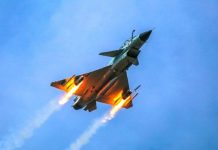With soaring tensions at the Line of Actual Control (LAC) in Ladakh, India and China are preparing for the approaching colder months in the unforgiving heights of Himalayas.
While the winter is going to be tough, it provides a silver lining to the Indian Air Force (IAF) against the People’s Liberation Army Air Force (PLAAF).
SAAB To Make Its Gripen Jets Stealth With Advanced Jammer Pods & Decoy Missiles
According to Manmohan Bahadur, a retired Air Vice Marshal who is now the Addl Director General at the Centre for Air Power Studies in New Delhi, the Chinese airfields lying at higher altitudes is a drawback in terms of what PLAAF can throw at the IAF and the Indian Army.
“China knows that and is trying to overcome it with its new radar and surface-to-air missile deployments – in effect, putting in place a dense, ground-based, air defence network,” he wrote.
Indian Air Force Will ‘Outdo’ Chinese PLAAF As India-China Conflict Approaching Winters
As reported earlier by EurAsian Times, the PLA air defence infrastructure is being constructed roughly 50 Kms from known clash points of the 2017 Doklam and 2020 clash points. Satellite images have also revealed that the PLA is reportedly constructing a surface-to-air missile site as well as other infrastructure on the banks of the Mansarovar Lake in the India-Nepal-China tri-junction area near the Lipulekh pass.

The former commander explained that China is gaining time for such construction activities by prolonging discussions. This is indicative of Beijing’s acceptance of their porous border which can be exploited by the IAF.
It is “building up its deterrence quotient through a strategy of denial whereby it feels that India would be forced to re‑think using its air force due the threat of an impenetrable air defence network put in place,” he added. He suggested that India needs to send a strong message and play by the strategy of ‘deterrence by punishment’ rather than ‘deterrence by denial’.
After two months of the brutal clash in the Galwan valley that killed 20 Indian troops, China’s ambassador to India, Sun Weidong, described it as an “unfortunate incident”, and a “brief moment from the perspective of history”.
US Warns Of Dangerous Build-Up Of China’s Nuclear Weapons & Ballistic Missiles; Beijing Hits Back
Former Air Vice Marshal called the statement as a “classic deception at work.” He raised the possibility of the Pakistan Air Force (PAF) giving China inputs and playing an active role behind the scenes as it seems to be following the “doctrine that Pakistan has used in its attempt to blunt the offensive foundation of Indian air power.”
“While this might be true, Beijing is playing the psy-war [Psychological warfare] to the hilt by parking its frontline assets, including the latest J‑20 stealth fighters, on the tarmac in forward airfields — in full view of satellites scouring the area from high above so as to send a message to New Delhi.
Some may say that there are no hard shelters to park the aircraft there, but that is only part of the argument because there are always options to get around it,” he stated.
India’s changing policy of offensive action was recently displayed when it retaliated PLA’s “provocative actions” on the Southern Bank of Pangong Tso. In a statement issued by the Indian Ministry Of Defense, on the night of 29/30 August 2020, PLA troops violated the previous consensus arrived at during military and diplomatic engagements during the ongoing standoff in Eastern Ladakh and carried out provocative military movements to change the status quo.
This is a clear indication of the ‘deterrence by punishment’ policy adopted by New Delhi. “Deployments would surely be getting reviewed and offensive assets, other than fighters (that require airfields to operate from), would also be getting tasked for a greater role in case of a shooting war.
We have the aerial resources to operate in those high altitude areas – we also have (always had) crew who must be straining at the leash to help restore the status quo ante,” asserted Bahadur.
He concluded by saying that the government’s stance must stay focussed on deterrence by punishment. “New Delhi must gainfully use the interlude to push through the agenda of augmenting indigenous defence R&D and manufacturing capacities,” he added.




